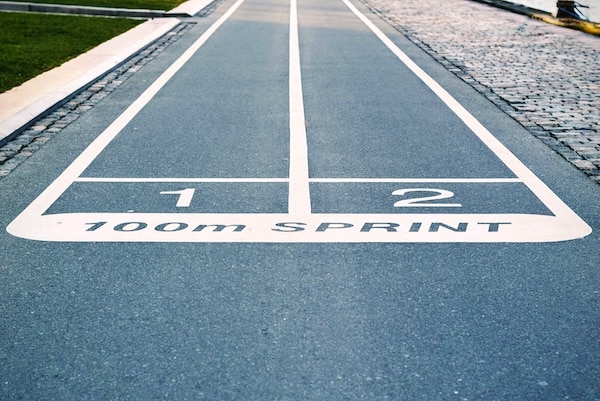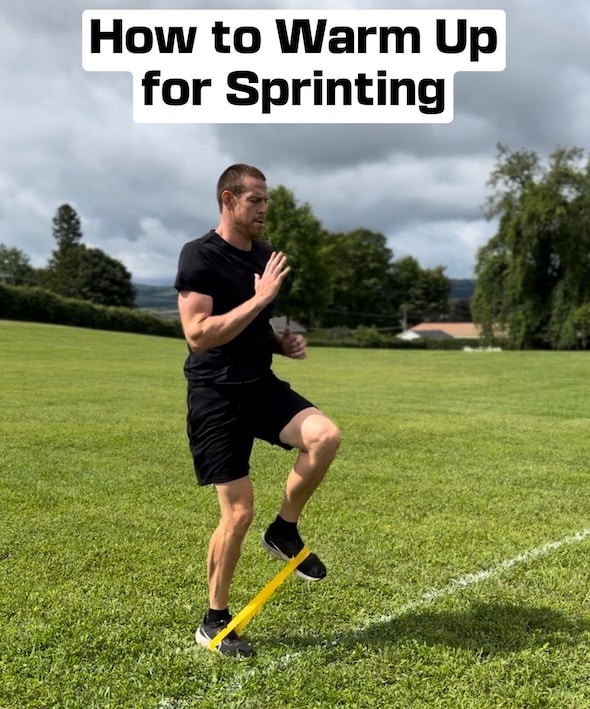How to Warm Up for Sprinting: A Step-by-Step Guide
Do you want to sprint faster?
Warming up properly before sprinting is crucial for both performance and injury prevention.
As a professional basketball player with over a decade of experience playing at the highest levels in Europe, I’ve learned that the key to explosive speed lies in a well-structured warm-up.
Over the years, I’ve refined my routine to ensure my body is fully prepared to handle the intense demands of sprinting on the court.
Here’s a detailed guide based on my personal routine that can help you maximize your sprinting performance while staying safe.
Step 1: Lower Body and Glute Activation with Mini Band Exercises
The first step in my warm-up routine involves using a mini band to activate the lower body and glutes. This ensures that these key muscle groups are ready to handle the intensity of sprinting. The mini band provides resistance that helps activate and strengthen the glutes, which play a significant role in sprinting power.
- Monster Walks: Place the mini band just above your knees, bend your knees slightly, and walk forward and backward with controlled steps, maintaining tension in the band.
- Lateral Monster Walks: With the mini band in the same position, take lateral steps to the side, ensuring your glutes are engaged throughout the movement.
- Body Squats: Perform squats while maintaining tension in the mini band to further engage your glutes.
- Additional Glute Exercises: You can include exercises like clamshells or glute bridges to ensure thorough activation.
Step 2: Dynamic Stretches
After activating your lower body, I transition into dynamic warm-up exercises. Dynamic stretching involves moving parts of your body and gradually increasing reach, speed of movement, or both.
This prepares your muscles and joints for the more intense activity to come.
Here are some common dynamic stretches I include:
- Leg Swings: Swing one leg forward and backward, then side to side, to loosen up the hips and hamstrings.
- High Knees: Perform high knees to engage your hip flexors and increase heart rate.
- Butt Kicks: Jog in place, bringing your heels up towards your glutes to activate the hamstrings.
- Walking Lunges with a Twist: Lunge forward and twist your torso toward the front leg to stretch the hip flexors and engage the core.
- Arm Circles: Rotate your arms in large circles to loosen up the shoulders and upper body.
- Inchworm: Walk your hands out into a plank position, then walk your feet toward your hands to stretch the hamstrings and activate the core and shoulders.
If I’m preparing to sprint, I also add in the following drills:
- Side Shuffles: Shuffle laterally to warm up the adductors and abductors.
- Back Pedals: Run backward to prepare your body for quick changes in direction.
- Carioca Exercise: Perform the Carioca (or grapevine) to improve hip mobility and coordination.
Step 3: Low to Moderate-Intensity Plyometrics

Plyometrics are a key part of my warm-up because they help to improve my explosiveness, which is crucial for sprinting. These exercises involve jumping and dynamic movements that condition your muscles and tendons for the powerful demands of sprinting.
Some of the plyometric exercises I include are:
- Pogo Jumps: Perform quick, low jumps with minimal knee bend, focusing on quick ground contact to improve ankle stiffness.
- Depth Drops: Step off a small box and land softly, focusing on absorbing the impact through your legs.
- Jump Squats: Perform a squat and explode into a jump, landing softly and repeating.
- Skips and Hops: Incorporate various skipping and hopping drills to further enhance coordination and power.
I sometimes use mini bands during these exercises to add resistance and increase the intensity.
Step 4: Gradually Increase Sprint Intensity
The final part of my warm-up involves gradually increasing the intensity of my sprints. This helps transition your body from warming up to full-speed sprinting, reducing the risk of injury while ensuring optimal performance.
I start with sprints at the following intensities:
- 60% Effort: Perform a few sprints at 60% of your maximum speed to ease into the movement.
- 70% Effort: Gradually increase the speed to 70%, focusing on maintaining good form.
- 80% Effort: Perform sprints at 80% effort to further prime your body for full-speed running.
When it’s time to sprint at full speed, I typically run at 87-90% of my maximum speed to maintain safety while still getting the benefit of a high-intensity sprint workout.
Step 5: Do Your Sprints!
Now that you’re fully warmed up and ready to go, it’s time to put your preparation into action and start sprinting.
Sprinting is one of the most efficient ways to boost cardiovascular fitness, build lean muscle, and torch body fat.
But to truly maximize your sprinting power and performance, there are a few key principles and workout options to consider.
Keys to Optimal Sprinting Power and Performance
To get the most out of your sprints, focus on the following elements:
- Explosive Start: Begin each sprint with an explosive burst of speed. This initial burst sets the tone for the rest of your sprint and maximizes your power output.
- Proper Form: Maintain a forward lean, drive your knees up, and keep your arms pumping in sync with your leg movement. Good form reduces the risk of injury and ensures that you’re maximizing your speed.
- Breathing: Breathe deeply and consistently, even though the intensity might make it challenging. Proper breathing ensures that your muscles receive the oxygen they need during high-intensity efforts.
- Recovery: Allow adequate recovery between sprints. The key to high-quality sprints is to give your body time to recover so you can perform at your best during each rep.
Best Sprint Workouts for Weight Loss and Performance
I’ve done hundreds of different sprint workouts throughout my career, but these are the best sprint workouts for weight loss I use consistently.
- 10x100m Sprint Workout: This workout is simple yet highly effective. Run ten 100-meter sprints at about 90% of your maximum speed. Walk back to the start to recover between sprints. If you’re a beginner, start with fewer sprints and gradually increase the volume. This workout helps to build speed and cardiovascular endurance while burning calories rapidly.
- Poliquin Sprints: A favorite of strength and conditioning coaches, this workout consists of 400m, 300m, 200m, and 100m sprints with decreasing rest periods between each. This sequence pushes your body to adapt to varying levels of fatigue, enhancing both endurance and power. It’s a challenging but rewarding workout that leads to significant fat loss and improved fitness.
- NFL 300-Yard Shuttle: This shuttle drill is a staple in NFL conditioning programs. It involves sprinting a 50-yard distance back and forth until you’ve completed 300 yards. Run three sets with three minutes of rest in between. This workout tests your speed, agility, and endurance, making it an excellent choice for advanced athletes.
- 20-20s: Run 20 suicides on a basketball court in 20 minutes, aiming to complete each suicide in under 40 seconds. This workout demands mental toughness and extreme conditioning, making it perfect for those looking to mimic the fitness level of professional athletes.
- Hill Sprints or Stair Runs: Find a steep hill or a long staircase and sprint to the top. Walk back down to recover, then repeat. These sprints build explosive lower-body power and elevate your heart rate quickly, making them highly effective for fat burning and leg strength.



